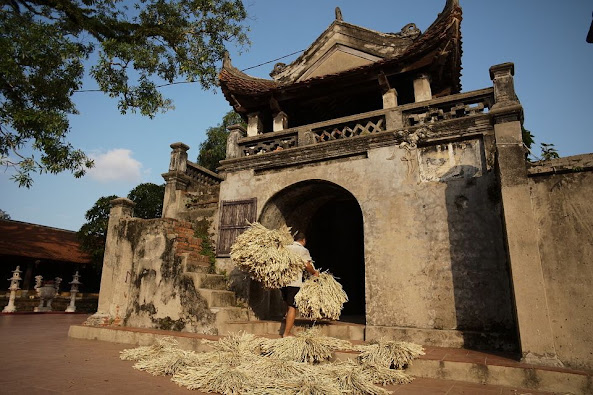Detailed Guide on How to Get to the Hat-Making Village, Ideal Visiting Times, and Recommended Activities
It is likely that Chuong Market emerged when the villagers began making hats? as materials had to be purchased?
Introduction
Few villages possess a wealth of architectural heritage as diverse and impressive as the ancient Vietnamese village of Chuong, now part of Phuong Trung commune, Thanh Oai district, Hanoi.
If you have the chance to visit such a historically rich village, you certainly cannot resist exploring the interconnected cultural relics recognized as national historical sites by the Ministry of Culture and Information on March 16, 1985, which include Chuong Temple, Chuong Pagoda, and Chuong Market.
Visiting Chuong Temple
First, we visit the Chuong village temple, which is believed to have existed for a long time, originally built simply with bamboo and thatch.
It was not until the early 19th century, during the reign of King Gia Long (1802-1819), that Vietnam entered a period of significant reforms and construction. The Nguyen Dynasty, starting with King Gia Long, greatly promoted and elevated Vietnamese temple culture to its peak in history.
In this context, during the reign of King Thanh Thai (1894), the village elders decided to construct a large and beautiful temple in the architectural style of the Nguyen Dynasty, rather than the old-fashioned style. According to preserved documents, the current Chuong village temple features an architecture shaped like the letter "C", consisting of the main hall, connecting areas, and the inner sanctum, all surrounded by protective walls, giving the entire complex a rectangular layout.
In the past:
Exploring Chuong Pagoda
Adjacent to Chuong Temple is Chuong Pagoda, known in classical terms as Thang Quang Tu (Thang Quan Pagoda). Located in the center of Chuong village, the pagoda is situated in the northwest, close to the banks of the Day River, making it an ideal spot for trade and interaction.
The layout of this area is organized logically, reflecting the cultural practices of Buddhism, Taoism, and traditional Vietnamese spirituality. From Chuong Market, looking directly at Chuong Pagoda, one can see various architectural features, including:
- The three-arch gate (Tam Quan)
- The main hall (Tam Bao)
- The Ancestor worship hall
- The Hall of the Mother Goddess
- The Hall of Saint Do Hue
- The Hall of Mother Lieu Hanh
The Historical Significance of Chuong Market
Finally, within this cultural heritage is Chuong Market, an ancient market famous throughout the Red River Delta. There are no existing documents detailing the market's early establishment, but local folklore has preserved the saying:
"On the tenth, visit Chuong Market,
Watch human chess, and see who cooks the best rice."
"Mồng mười đi chợ Chuông chơi,
Xem đánh cờ người, xem thổi cơm thi."
Human chessboard:
This village and its craft have left a mark on folk culture for hundreds, if not thousands, of years. To this day, we still see "human chess" and "rice cooking contests" celebrated on that traditional tenth day. It is amazing and a source of pride!
Chuong Market attracts visitors from near and far, with its reputation spreading throughout the Red River Delta, largely due to the "hat-making profession." This traditional craft contributes significantly to the prosperity of Chuong village. Perhaps it is the value of the hats that has led to the renowned brand "Chuong Hats."
Chuong villagers tirelessly seek and gather materials from various provinces to create different types of hats: thúng quai thao, pineapple-top, mature leaves, and young leaves. It is likely that Chuong Market emerged when the villagers began making hats, as materials had to be purchased, and once a hat was made, it had to be sold immediately to recover costs and support families. Thus, Chuong Market was established in this context.











.jpg)
Nhận xét
Đăng nhận xét